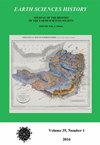论砂岩的分类
IF 0.6
4区 哲学
Q4 GEOSCIENCES, MULTIDISCIPLINARY
引用次数: 1
摘要
在过去的四分之三个世纪里,人们发展了各种以颗粒为基础的分类系统,以便根据三种最常见成分(石英、长石和岩石碎片)的相对丰度对砂岩进行分类。对砂岩分类的历史发展进行了回顾,以阐明以各种分类方法为代表的地质认识的演变。传统砂岩分类中定义的成分场与根据解释的沉积构造物源分组的砂岩亚群在很大程度上是不相容的。这种描述性分类和成因分类之间的不相容的根源在于,这两种分类方法都没有根据控制砂岩成分起源和演化的已知过程来建立分类场边界。本文综述了影响砂岩岩石成因和颗粒组成的一系列因素的研究进展,并介绍了几种适用于多组分颗粒丰度分析的关键统计技术。根据对这些分类实践进展的评价所获得的理解,介绍了一组未来需要考虑的潜在主题。本文章由计算机程序翻译,如有差异,请以英文原文为准。
ON THE CLASSIFICATION OF SANDSTONES
Over the last three-quarters of a century various grain-based classification systems have been developed in order to categorize sandstones on the basis of the relative abundances of their three most common components: quartz, feldspar, and rock fragments. A review of the historical development of sandstone classification is undertaken to elucidate evolution in geological understanding represented by various methodologies of classification. The compositional fields defined in traditional sandstone classifications are found to be largely incompatible with subpopulations of sandstones grouped according to interpreted sedimentary tectonic provenance. The origin of this incompatibility between descriptive classifications and genetic classifications arose from the fact that neither approach established classification field boundaries on the basis of processes known to control the origin and evolution of sandstone composition. The development of the study of a range of factors that influence sandstone petrogenesis and grain composition are reviewed along with the introduction of several critical statistical techniques applicable to multicomponent grain abundance analysis. From the understandings gained by the evaluation of these advances in classification practice a set of potential topics for future consideration are introduced.
求助全文
通过发布文献求助,成功后即可免费获取论文全文。
去求助
来源期刊

Earth Sciences History
GEOSCIENCES, MULTIDISCIPLINARY-HISTORY & PHILOSOPHY OF SCIENCE
CiteScore
1.00
自引率
0.00%
发文量
1
审稿时长
>12 weeks
期刊介绍:
Earth Sciences History promotes and publishes historical work on all areas of the earth sciences – including geology, geography, geophysics, oceanography, paleontology, meteorology, and climatology.
The journal honors and encourages a variety of approaches to historical study: biography, history of ideas, social history, and histories of institutions, organizations, and techniques.
Articles are peer reviewed.
 求助内容:
求助内容: 应助结果提醒方式:
应助结果提醒方式:


